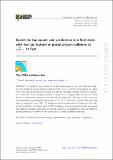Search for top squark pair production in a final state with two tau leptons in proton-proton collisions at √s = 13 TeV
Author(s)
The CMS Collaboration; Abercrombie, Daniel Robert; Allen, Branden; Baty, Austin Alan; Bi, Ran; Brandt, Stephanie Akemi; Busza, Wit; Cali, Ivan Amos; D'Alfonso, Mariarosaria; Gomez-Ceballos, Guillelmo; Goncharov, Maxim; Harris, Philip Coleman; Hsu, David; Hu, Miao; Klute, Markus; Kovalskyi, Dmytro; Lee, Y.-J.; Luckey Jr, P David; Maier, Benedikt; Marini, Andrea Carlo; McGinn, Christopher Francis; Mironov, Camelia Maria; Narayanan, S.; Niu, Xinmei; Paus, Christoph M. E.; Rankin, Dylan S.; Roland, Christof E; Roland, Gunther M; Shi, Z.; Stephans, George S. F.; Sumorok, Konstanty C; Tatar, Kaya; Velicanu, Dragos Alexandru; Wang, J.; Wang, T. W.; Wyslouch, Boleslaw; ... Show more Show less
DownloadPublished version (1.295Mb)
Publisher with Creative Commons License
Publisher with Creative Commons License
Creative Commons Attribution
Terms of use
Metadata
Show full item recordAbstract
© 2020, The Author(s). A search for pair production of the supersymmetric partner of the top quark, the top squark, in proton-proton collision events at s = 13 TeV is presented in a final state containing hadronically decaying tau leptons and large missing transverse momentum. This final state is highly sensitive to high-tan β or higgsino-like scenarios in which decays of electroweak gauginos to tau leptons are dominant. The search uses a data set corresponding to an integrated luminosity of 77.2 fb−1, which was recorded with the CMS detector during 2016 and 2017. No significant excess is observed with respect to the background prediction. Exclusion limits at 95% confidence level are presented in the top squark and lightest neutralino mass plane within the framework of simplified models, in which top squark masses up to 1100 GeV are excluded for a nearly massless neutralino. [Figure not available: see fulltext.]
Date issued
2020Department
Massachusetts Institute of Technology. Department of Physics; Massachusetts Institute of Technology. Laboratory for Nuclear ScienceJournal
Journal of High Energy Physics
Publisher
Springer Science and Business Media LLC